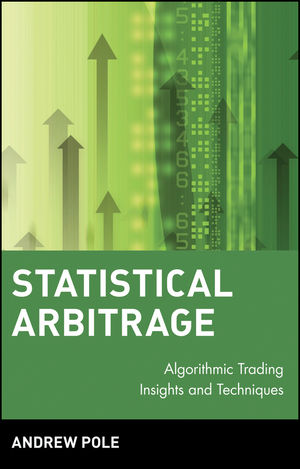Statistical Arbitrage: Algorithmic Trading Insights and TechniquesISBN: 978-0-470-13844-1
Hardcover
256 pages
October 2007
 This is a Print-on-Demand title. It will be printed specifically to fill your order. Please allow an additional 15-20 days delivery time. The book is not returnable.
|
||||||
Foreword.
Acknowledgments.
Chapter 1. Monte Carlo or Bust.
Beginning.
Whither? And Allusions.
Chapter 2. Statistical Arbitrage.
Introduction.
Noise Models.
Reverse Bets.
Multiple Bets.
Rule Calibration.
Spread Margins for Trade Rules.
Popcorn Process.
Identifying Pairs.
Refining Pair Selection.
Event Analysis.
Correlation Search in the Twenty-First Century.
Portfolio Configuration and Risk Control.
Exposure to Market Factors.
Market Impact.
Risk Control Using Event Correlations.
Dynamics and Calibration.
Evolutionary Operation: Single Parameter Illustration.
Chapter 3. Structural Models.
Introduction.
Formal Forecast Functions.
Exponentially Weighted Moving Average.
Classical Time Series Models.
Autoregression and Cointegration.
Dynamic Linear Model.
Volatility Modeling.
Pattern Finding Techniques.
Fractal Analysis.
Which Return?
A Factor Model.
Factor Analysis.
Defactored Returns.
Prediction Model.
Stochastic Resonance.
Practical Matters.
Doubling: A Deeper Perspective.
Factor Analysis Primer.
Prediction Model for Defactored Returns.
Chapter 4. Law of Reversion.
Introduction.
Model and Result.
The 75 percent Rule.
Proof of the 75 percent Rule.
Analytic Proof of the 75 percent Rule.
Discrete Counter.
Generalizations.
Inhomogeneous Variances.
Volatility Bursts.
Numerical Illustration.
First-Order Serial Correlation.
Analytic Proof.
Examples.
Nonconstant Distributions.
Applicability of the Result.
Application to U.S. Bond Futures.
Summary.
Appendix 4.1: Looking Several Days Ahead.
Chapter 5. Gauss is Not the God of Reversion.
Introduction.
Camels and Dromedaries.
Dry River Flow.
Some Bells Clang.
Chapter 6. Interstock Volatility.
Introduction.
Theoretical Explanation.
Theory versus Practice.
Finish the Theory.
Finish the Examples.
Primer on Measuring Spread Volatility.
Chapter 7. Quantifying Reversion Opportunities.
Introduction.
Reversion in a Stationary Random Process.
Frequency of Reversionary Moves.
Amount of Reversion.
Movements from Quantiles Other Than the Median.
Nonstationary Processes: Inhomogeneous Variance.
Sequentially Structured Variances.
Sequentially Unstructured Variances.
Serial Correlation.
Appendix 7.1: Details of the Lognormal Case in Example.
Chapter 8. Nobel Difficulties.
Introduction.
Event Risk.
Will Narrowing Spreads Guarantee Profits?
Rise of a New Risk Factor.
Redemption Tension.
Supercharged Destruction.
The Story of Regulation Fair Disclosure (FD).
Correlation During Loss Episodes.
Chapter 9. Trinity Troubles.
Introduction.
Decimalization.
European Experience.
Advocating the Devil.
Stat. Arb. Arbed Away.
Competition.
Institutional Investors.
Volatility Is the Key.
Interest Rates and Volatility.
Temporal Considerations.
Truth in Fiction.
A Litany of Bad Behavior.
A Perspective on 2003.
Realities of Structural Change.
Recap.
Chapter 10. Arise Black Boxes.
Introduction.
Modeling Expected Transaction Volume and Market Impact.
Dynamic Updating.
More Black Boxes.
Market Deflation.
Chapter 11. Statistical Arbitrage Rising.
Catastrophe Process.
Catastrophic Forecasts.
Trend Change Identification.
Using the Cuscore to Identify a Catastrophe.
Is It Over?
Catastrophe Theoretic Interpretation.
Implications for Risk Management.
Appendix 11.1: Understanding the Cuscore.
Bibliography.
Index.



